On Being Pagan in Prison
The complexity and challenges of pagan belief in American prisons. Story and images by Lauren Pond.
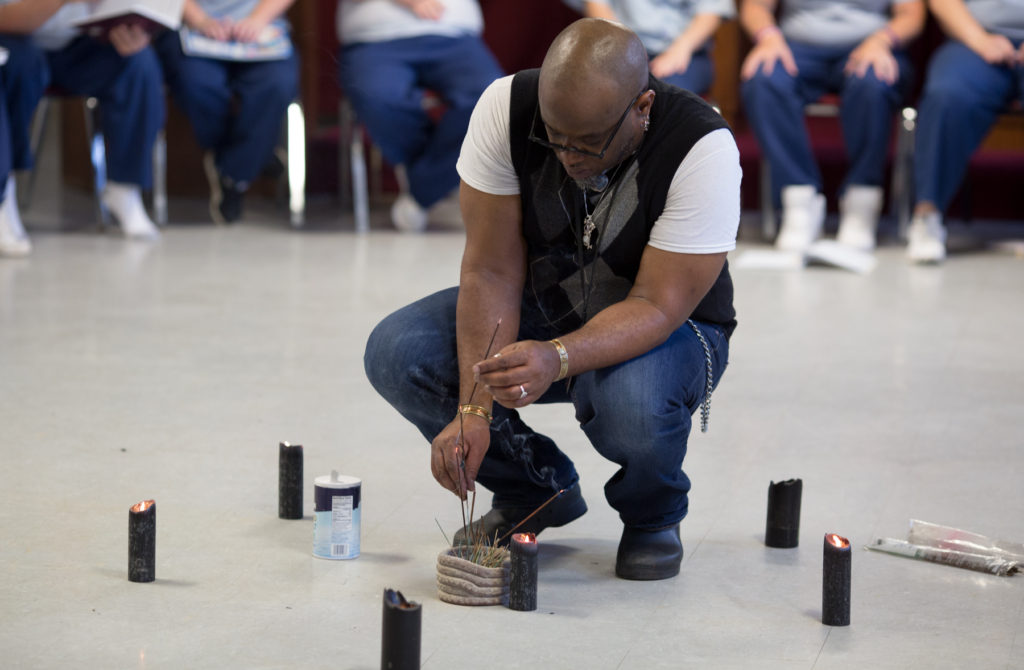
Brian Edwards, a Wiccan High Priest and paid contractor with the Ohio Department of Rehabilitation and Correction, prepares to lead a ritual with prisoners at the Ohio Reformatory for Women (ORW) in Marysville, Ohio, on May 31, 2018. He used incense to cleanse the area and candles to balance different forces, then cast a sacred circle, within which the ritual took place. Edwards visits ORW twice monthly, both providing educational guidance for the women there and leading them in rituals. Approximately 300 prisoners at ORW identify as pagan.
With her eyes wide and her hands thrust before her, Kerry Vadasz, a practitioner of Wicca, works to banish impurities from the space where she is participating in a group ritual. As she leans forward, an intricate medallion — what appears to be a combination of a lotus flower and the traditional Wiccan pentacle — dangles from her neck. Next to it hangs an identification card with her headshot, a barcode, and bold, white letters: “INMATE.”
Vadasz is one of about 300 prisoners at the Ohio Reformatory for Women in Marysville, Ohio, who identify as pagan, and one of approximately 3,000 with this religious affiliation in the state, according to the Ohio Department of Rehabilitation and Correction (ODRC). She is also part of a growing number of prisoners nationwide who belong to such communities – a demographic that correctional facilities find themselves increasingly pressed to understand and accommodate.
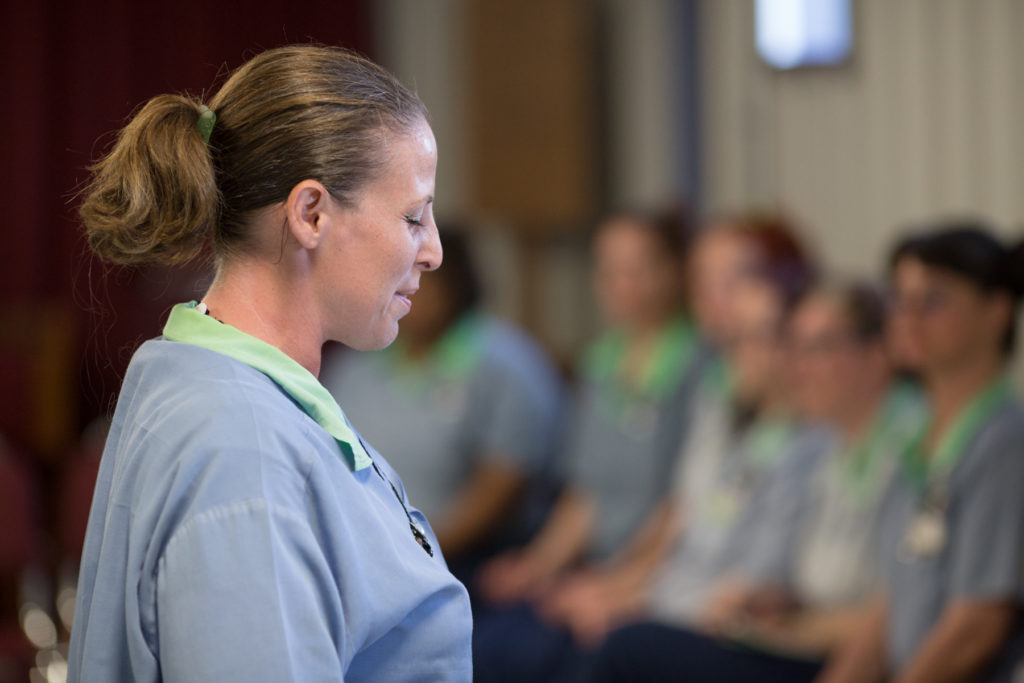
Kerry Vadasz, a Wiccan practitioner at the Ohio Reformatory for Women, centers herself in preparation to perform the Lesser Banishing Ritual of the Pentagram, a practice used to rid a sacred space of impure or chaotic elements. Although the rituals Edwards leads are Wiccan and occult in feel, aspects of them are applicable across pagan traditions, he said. The women he assists have a variety of different pagan backgrounds and beliefs.
Broadly speaking, paganism encompasses an eclectic mix of nature-based, polytheistic traditions – many of which, adherents believe, are rooted in ancient, pre-Christian practices – that started gaining popularity in the mid-20th century. Unlike mainstream, monotheistic religions, Wicca, Asatru, Druidry, and others often avoid dogma and tend not to have central texts or authorities. Many offer freedom of interpretation and practice. Although exact numbers remain elusive, Harvard’s Pluralism Project suggests that the U.S. pagan population could be upwards of one million.
That such belief systems would thrive in the highly regulated prison environment may seem counterintuitive, not to mention logistically difficult. And yet, according to a 2012 survey by the Pew Forum, more than a third of American prison chaplains reported that pagan communities were growing in their facilities. In this survey, significantly, Pagan/earth-based religions were given an explicit category of their own instead of being lumped together with other minority religions, as they often are. The prison chaplains surveyed estimated that about 1.7 percent of prisoners adhered to such religions (a percentage that, if extrapolated to the U.S. prison population, would suggest that there were about 40,000 incarcerated people in 2012 with this religious affiliation). Since then, prison officials and clergy continue to note an uptick.

One woman anoints another with oil in preparation for the ritual, which focused on honoring earth and seeking balance with the natural elements. Although the rituals that Edwards leads are Wiccan and occult in feel, aspects of them are applicable across pagan traditions, he said. About 40 prisoners of diverse pagan backgrounds participated in the gathering, which was held in a room utilized by multiple religious groups.
Although there are many reasons prisoners might choose to follow a religious tradition, the growth of paganism could have to do with America’s changing religious landscape, suggested Mike Davis, Religious Services Administrator for the ODRC, explaining, “I believe that the trends in religious practice that occur within the correctional system reflect the religious diversity, and religious pluralism, that shape our entire culture.”
Religion is also widely viewed as a moral, corrective force for prisoners and a way to help reduce recidivism. Christianity, in particular, has a long history in American prisons; in fact, principles of “human sinfulness and redemptive possibility” formed the very foundation of the American penitentiary movement, according to religion scholar Jennifer Graber in her book The Furnace of Affliction: Prisons and Religion in Antebellum America. Today, prisons are very religiously diverse, and laws like RLUIPA (the Religious Land Use and Institutionalized Persons Act) require facilities not to restrict religious practices unless there is an important reason to do so, such as safety. Prisons typically accommodate different religions through the efforts of both staff chaplains and external volunteers.
Although pagan traditions do not use language of sin and redemption, adherents emphasize that their traditions also offer rehabilitative possibilities. Vadasz, a former Jehovah’s Witness, said that the ability to worship a goddess instead of a masculine god can be therapeutic for women, especially those scarred by trauma involving men. She also finds the practice of introspection to be extremely helpful.
“To me, it’s freeing. I can be me,” she said, later adding, “My being feels empowered.”
Mindfulness and self-awareness are at the core of work done by Brian Edwards, a Wiccan High Priest and the first paid pagan prison clergy member to be hired by the state of Ohio, the ODRC informed him. He travels twice monthly to the Ohio Reformatory for Women, where he regularly oversees about 40 prisoners, including Vadasz, in lessons and rituals.
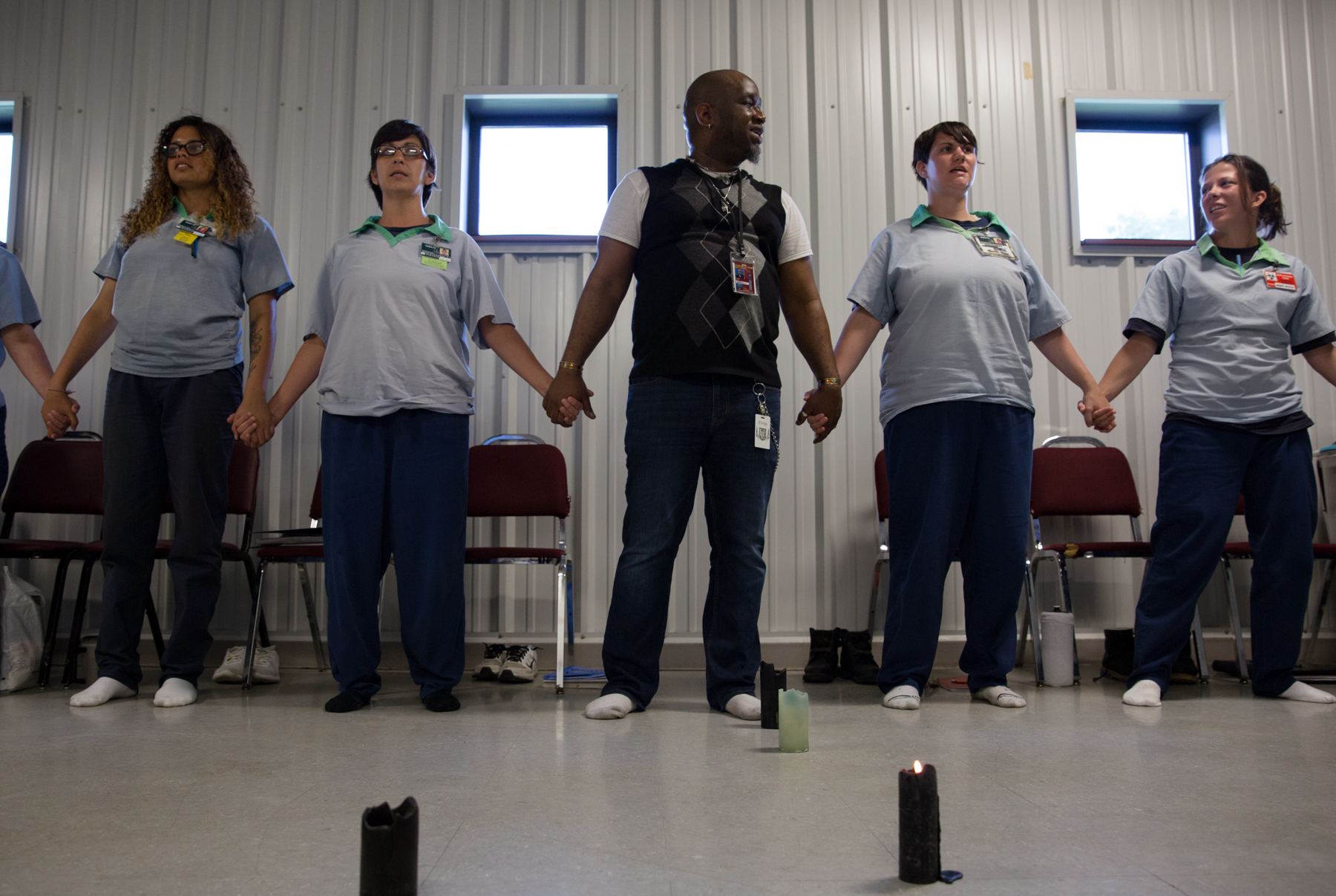
Brian Edwards joins hands with prisoners at the Ohio Reformatory for Women as he guides them in the Cone of Power, a practice of raising and directing energy through chants and song.
“It is easier for someone to put a parachute on and to jump out of a plane . . . than to turn inward and reflect on one’s emotional landscape,” he said. “That is the scariest place for a person to look.”
The sessions that Edwards leads tend to be Wiccan and occult in feel, but applicable across pagan traditions, he said. He also offers one-on-one guidance to the women and assists them in finding resources for their individual pagan practices.
Among other topics, Edwards educates the prisoners about the natural elements — earth, air, fire, water — believed to be in every person, and about the psychology attached to each; fire, for instance, is associated with passion, the ability to create, and the ability to destroy. His students can then contemplate how the elements function inside of them personally, how these may be out of balance, and how to get them back in harmony. Edwards also helps the women understand any “supernormal” experiences and abilities that may be present in their lives, such as having visions, which can easily lead to destructive impulses, but with proper guidance, can be channeled in productive ways, he explained.
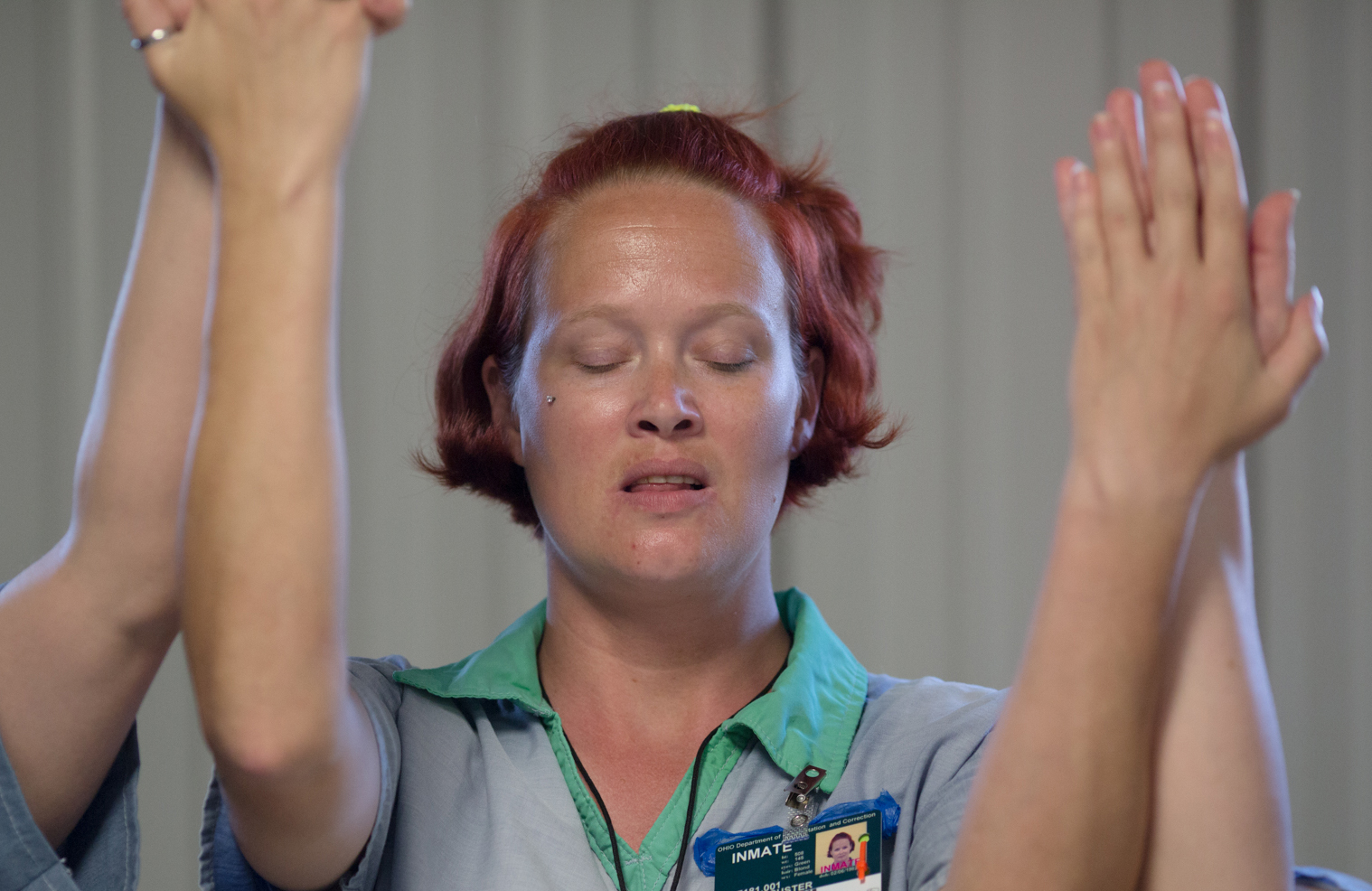
A woman participates in the Cone of Power, a collective practice of raising and directing energy through chants and song.
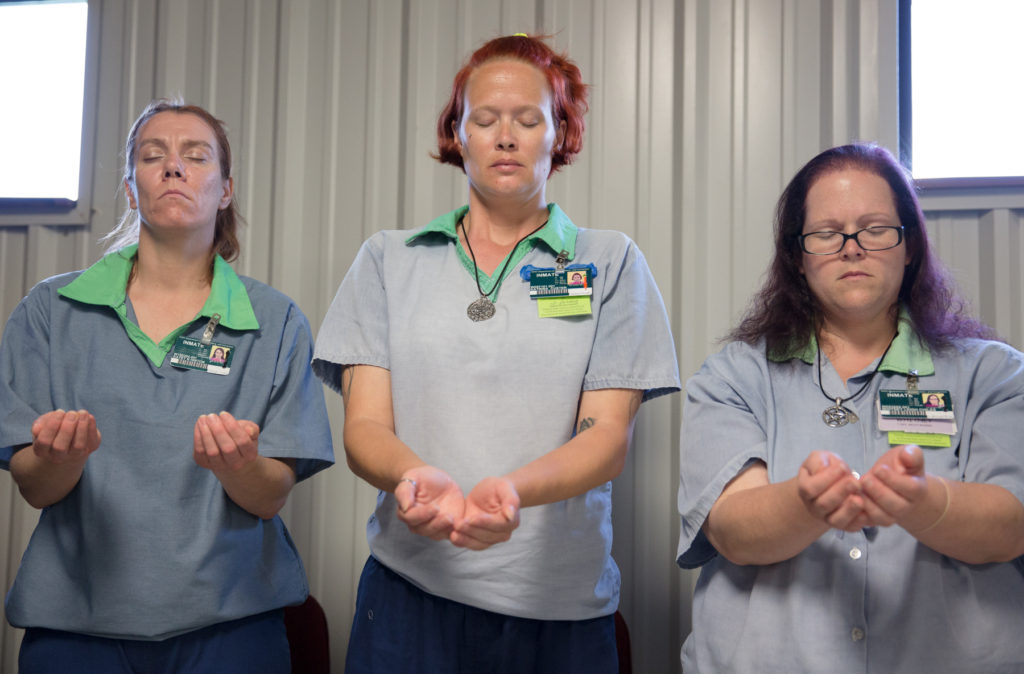
Women cup their hands to receive blessings during the ritual on May 31, 2018.
“Either you learn how to use these abilities, or these abilities will use you,” he said.
At other correctional facilities in Ohio and elsewhere, volunteers guide prisoners in the practice of heathenry, which centers on beliefs and practices thought to have originated in ancient northern Europe. The tradition of Asatru, which is rooted primarily in Norse mythology and folklore, encourages practitioners to lead noble lives, and to honor each other and their ancestors. Concepts such as frith – which emphasizes one’s responsibility toward one’s community and family — resonate with some prisoners.
“I think of it more as a way of life. It’s an honorable way of life. It’s how you should live,” said one follower of Asatru incarcerated at the California State Prison, Los Angeles County.
At this facility, he and other men have formed the Fara Af Tr’u (Journey of Faith) kindred, a group to observe and study Asatru. Some of the men are now pursuing higher education as a result, said Chaplain Abdul-Wahab Omeira, who is the prison’s Muslim chaplain, but has helped oversee pagan practitioners. Others have had their sentences reduced.

Thomas Wheelock, an incarcerated follower of Asatru, lectures to fellow prisoners during a Yule ceremony at the California State Prison, Los Angeles County – a maximum-security men’s facility in Lancaster, California – on December 24, 2014. As gothi, or priest, of the Fara Af Tr’u (Journey of Faith) kindred, he helps lead a small group of men in studying and observing Asatru, a heathen religion thought to be rooted in the beliefs and practices of ancient northern Europe, especially Scandinavia. The tradition draws on literature such as the Icelandic sagas and Eddas. During Yule, a celebration of the winter solstice, Norse gods including Odin, Thor, and Freyr are typically honored through feasting and ceremony.
But paganism faces a number of challenges in carceral facilities, including a lack of resources – namely, a shortage of clergy. Prisons often do not have staff chaplains who are trained in pagan traditions, leaving prisoners largely reliant on unpaid, external volunteers for guidance and rituals. Mike Davis emphasized the difficulty of finding willing providers, and of accommodating the growing diversity of pagan religions. According to the 2012 Pew survey, 35 percent of prison chaplains nationwide said more volunteers were needed to assist pagans. Only the need for Muslim volunteers ranked higher.
Additionally, there are issues of race and extremism to contend with. Because of their associations with northern Europe, heathen religions in particular are often fraught with racial politics: While some adherents believe heathenry can be practiced by anyone, others believe it should be reserved for people of this specific ancestry. Heathen traditions and their symbology have been attractive to white supremacists — especially in prisons, where racial divisions run deep. Some prisoners have also allegedly cited heathenry as justification for violence: For example, in a Virginia facility, an incarcerated follower of Asatru murdered another prisoner at a makeshift altar and claimed that the Norse gods had inspired his actions. The shortage of resources may make pagan prisoners more vulnerable to these kinds of ideologies.
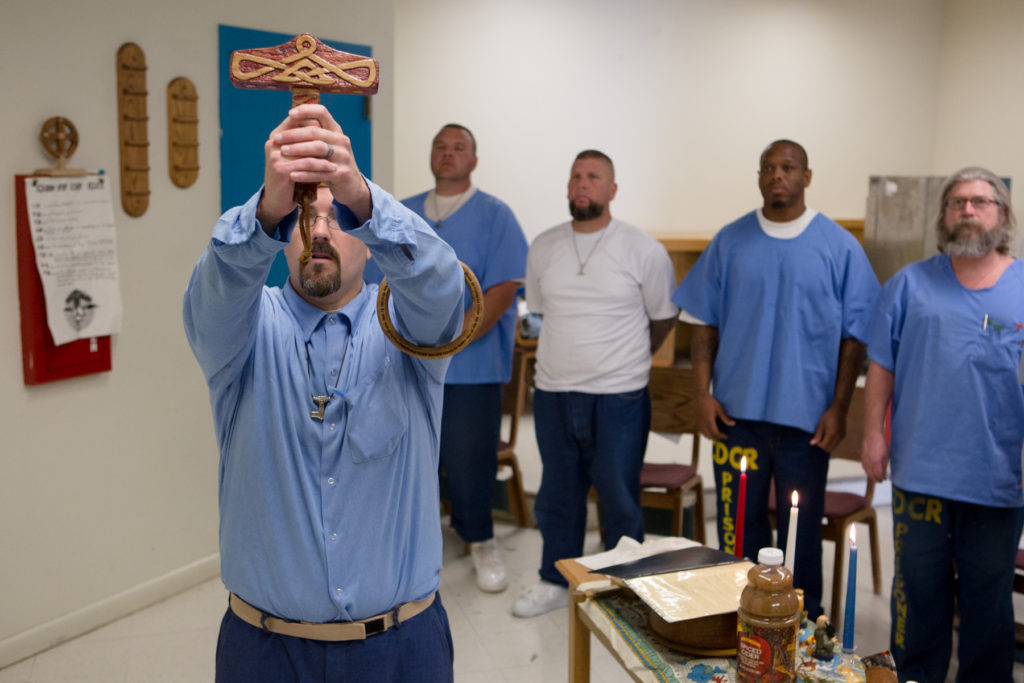
Wheelock uses a Thors hammer to hallow a sacred space for the Fara Af Tr’u kindred Yule ceremony at the prison. Asatru emphasizes living a noble life, honoring ones ancestors, and recognizing the far-reaching impact of ones actions concepts that resonate with some prisoners. However, because of their association with northern Europe, heathen religions like Asatru and its counterpart, Odinism, are sometimes attractive to white supremacists particularly in prisons, where racial divisions run especially deep. Knowing this, the kindred has striven to remain inclusive of racial minorities.
Prison officials are cautious, and, for instance, may vet literature and religious items before pagan prisoners are permitted to use them. Depending on the facility, pagans may not be able to gather for meetings or rituals without approved clergy to oversee them. But some prisons have reportedly taken such discipline a step further and engaged in discriminatory and retaliatory behavior. There have been many lawsuits, including one filed by William Rouser, a Wiccan prisoner in California, who claimed he was repeatedly denied access to basic religious items, such as oils and herbs. In response to his complaints, he said, prison staff put him in solitary confinement.
“I think it’s just ignorance. People don’t understand, and what they don’t understand they’re afraid of,” said Lisa Morgenstern, an ordained priestess who belongs to the international heathen organization known as The Troth and volunteers at prisons in California. She recalled hearing a prison staff member mock pagans as “devil worshippers.”
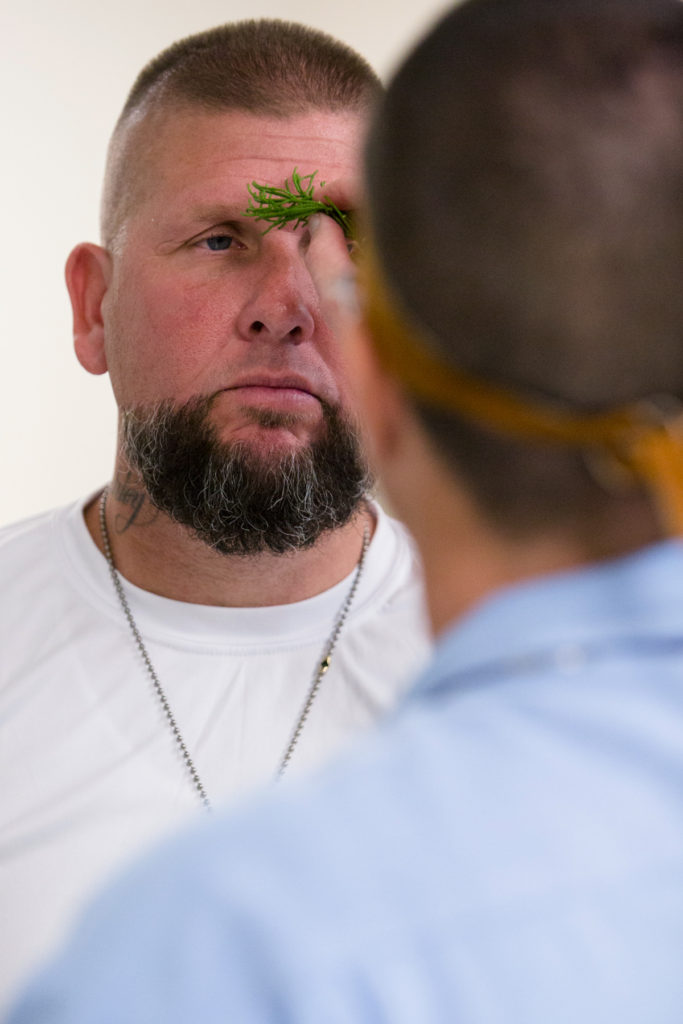
Wheelock uses an evergreen sprig to trace a rune a type of ancient symbol on the forehead of another Asatru practitioner, blessing him during the Yule ceremony on December 24, 2014. The days festivities were facilitated by Lisa Morgenstern, a volunteer from an international heathen organization known as The Troth, and overseen by Chaplain Abdul-Wahab Omeira, a Muslim prison chaplain also responsible for overseeing pagan prisoners.
Issues like these are motivating members of the American pagan community to act. Prisoners themselves are working to change perceptions of their beliefs. For instance, members of the Fara Af Tr’u kindred in California are aware of the racial politics of heathenry, so they have striven to be inclusive of minorities. Outside organizations including The Troth and the Appalachian Pagan Ministry also engage in “in-reach” at prisons across the country, providing guidance for incarcerated people, educating prison staff, and working to curtail extremism. They also field mail and literature requests from prisoners. Supported primarily by donations, Rev. Donna Donovan, founder of the Appalachian Pagan Ministry, and a colleague spend multiple days on the road each month serving pagan people in nine Ohio prisons and several West Virginia facilities. Some of the prisoners they serve are on death row.
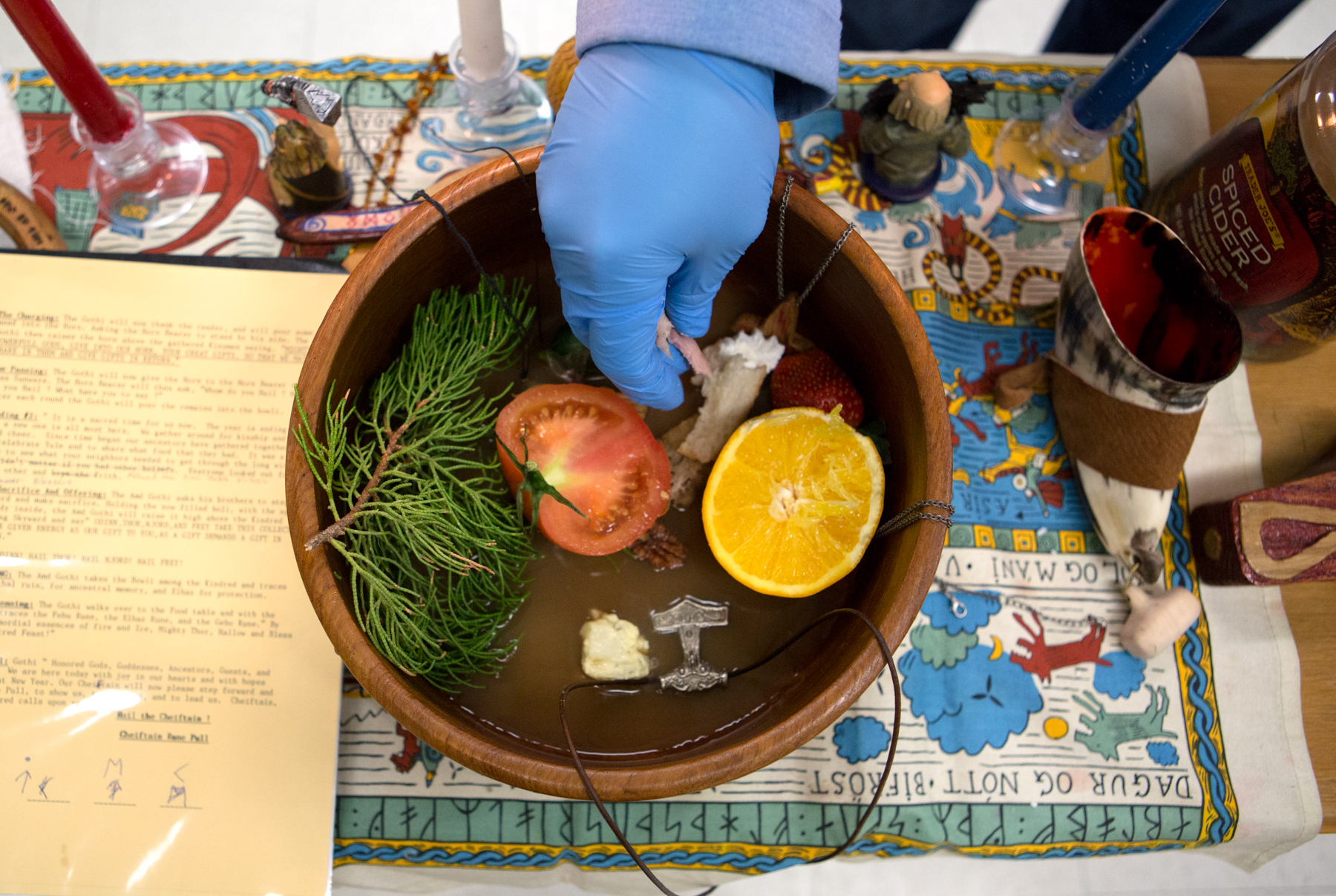
A member of the Fara Af Tr’u kindred prepares an offering for gods and land spirits during the Yule ceremony.
Prisons, too, are actively seeking assistance for pagans. The ODRC recently hired Brian Edwards to serve as pagan clergy at a second facility, the Marion Correctional Institution in Marion, Ohio. However, due to his full-time day job, the requests can be overwhelming, he said, and he wishes there were more help available.
“People need to be aware of the fact that there is this need out here,” he said. It’s a huge one.”

Members of the Fara Af Tr’u kindred and guests partake in a banquet following the Yule ceremony on December 24, 2014. Kindred members saved up about $200 to pay for all of the food, which included several hams, bread, veggie trays, cupcakes, pie, and soda.
***
Lauren Pond is a documentary photographer who specializes in faith and religion. She is currently a multimedia producer for the Ohio State University’s Center for the Study of Religion, where she uses photography and sound to study Ohio’s diverse religious communities, including neopagan movements and the Ethiopian Orthodox Tewahedo Church. In 2017, Lauren published Test of Faith: Signs, Serpents, Salvation (Duke University Press), a photography book about Pentecostal serpent handlers, which received the 2016 Duke Center for Documentary Studies/Honickman First Book Prize in Photography. Lauren received dual Bachelor’s degrees in journalism and art from Northwestern University in 2009, and a Master’s degree in photojournalism from Ohio University in 2014.
***
Published with support from the Henry R. Luce Initiative on Religion in International Affairs.